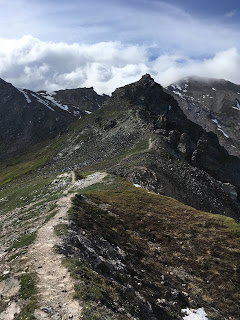 I flew out from New York City this past Sunday. After a stop in Seattle and a night in the Fairbanks airport, I caught the Denali Star train on the Alaska Railroad, which stops right in the park. There I was met by my supervisor for the summer and former ProRanger, Meaghan Page.
I flew out from New York City this past Sunday. After a stop in Seattle and a night in the Fairbanks airport, I caught the Denali Star train on the Alaska Railroad, which stops right in the park. There I was met by my supervisor for the summer and former ProRanger, Meaghan Page. 
After a quick tour of the front-country area of the park I got to meet the head honcho, Superintendent Don Striker, and stay a night in the apartment in his house while my housing was being sorted out. We grabbed a bite to eat and I got to see the film version of the bus from Into the Wild.
Meaghan arranged for me to be off for a couple days so that I could settle in, and she had a few days off right away herself anyway. This worked out perfectly, because I had fallen a little under the weather while making my way out here and needed to recover. The next day, I was assigned to my housing, a charming little cabin in C-Camp, the area where the park’s seasonal employees and some of the permanent ones reside. I pretty much rested all day.
The next day, Wednesday, was a beautiful day, and I was feeling a little better. So I went on a walkabout to familiarize myself with the area. There are walking trails that connect all the locations in the front country. The same places accessed by the trails appear a little different than when accessed by the park road, and I still wasn’t really familiar with that.
I made it over to the visitor center, where I spent some time checking out the displays and reading the information, some quality interpretation. I also watched the backcountry orientation video and got the safety talk, which means now I am ready to get permits to go on backpacking trips into the backcountry.
On the way back to C-Camp I had a fairly close encounter with a fairly large moose. Luckily I had just watched that video, which refreshed me on how to handle it. In the evening I did yoga with some folks from C-Camp.
Thursday, I headed to the Kennels, where the park houses their Sled Dogs. It is also where my roommate for the summer, Malik, works. There, I watched the demonstration and learned a bunch of interesting things. Firstly, Denali is the only national park unit that has a sled dog program. The dogs they keep are all Alaskan Huskies, not a distinct breed recognized by the American Kennel Association or other kennel clubs, but rather a mixture of breeds and nevertheless the sled dogs of choice.
| Ranger Lian gives an interpretive talk |
 |
| The dogs are controlled prior to harnessing by keeping their front feet off of the ground |
The dogs are used in the wintertime to navigate in the wilderness area of the park, where no mechanized equipment is allowed. They are occasionally taken on patrol, but are mostly used to haul any supplies or materials into the park. I also learned that pound for pound, sled dogs are the strongest draft animals, stronger than horses or oxen.
| This pup looks just like my dog, Champ (who is a husky shepherd mix) |
On Friday, I walked one of the short trails in the front-country area. Then I went to the grocery store with a couple guys from C-Camp to stock up. Meaghan had taken me when I arrived to pick up a few things, but as my housing wasn’t set yet and there was only a mini fridge in the apartment I stayed in the first night, I didn’t get much food. She told me the local grocery store opened last year, and before that everyone drove two hours to Fairbanks to shop.
In the evening I hiked another of the front country trails, the Mount Healy Overlook Trail.
 Sunday Ranger Page was back but had the evening shift, so I spent my morning with Ranger Chris Shore (AKA C-Shore). We drove out Andrew Kirby from Resource Management and General Ranger Sarah Hayes who were embarking on a survey mission to see if there were salmon returning to the rivers in part of the park to spawn. Surveys had been conducted up to the park boundary, but not within the park. To get to their desired location, we had to drive for a while on the highway, take a dirt road, cross a river, and get as far as we could to another river, where they would carry on by foot and with pack rafts. They would stay out for a few days collecting data and then be picked up. The only problem was the condition of the first river and the road was unknown, as no one had been out there in a while. Ranger Shore, who was driving and had to make the return trip with just me, had never made the river crossing or even been to the area. Before heading out we all sat down with Ranger Larson and did a GAR, a method for calculating risk. This was to get everyone on the same page and have plans for mitigating those risks before beginning. GAR stands for green, amber red, and involves certain categories that are assigned numbers corresponding to the risk involved/comfort level of the team members. The numbers are then added up and fall into one of the three categories.
Sunday Ranger Page was back but had the evening shift, so I spent my morning with Ranger Chris Shore (AKA C-Shore). We drove out Andrew Kirby from Resource Management and General Ranger Sarah Hayes who were embarking on a survey mission to see if there were salmon returning to the rivers in part of the park to spawn. Surveys had been conducted up to the park boundary, but not within the park. To get to their desired location, we had to drive for a while on the highway, take a dirt road, cross a river, and get as far as we could to another river, where they would carry on by foot and with pack rafts. They would stay out for a few days collecting data and then be picked up. The only problem was the condition of the first river and the road was unknown, as no one had been out there in a while. Ranger Shore, who was driving and had to make the return trip with just me, had never made the river crossing or even been to the area. Before heading out we all sat down with Ranger Larson and did a GAR, a method for calculating risk. This was to get everyone on the same page and have plans for mitigating those risks before beginning. GAR stands for green, amber red, and involves certain categories that are assigned numbers corresponding to the risk involved/comfort level of the team members. The numbers are then added up and fall into one of the three categories. We got out there and found the river flooding a large section of the road, but after checking it out determined it to be passable. The spot where the river normally crosses the road had a very low volume of water. We carried on and the road got increasingly muddy, to the point where we decided to turn around.
Monday was the first full day I spent with Ranger Page. We did a patrol of the front country area and gave a warning for a dog off leash. We also had a small moose jam (traffic caused by visitors viewing a moose) that pretty much resolved itself. We patrolled out west in the park, to the Igloo Campground at mile 34 on the park road. The farthest I had been so far was Headquarters and the Dog Kennels in between miles three and four. On the way back we saw a Caribou! Later I tagged along while Ranger Page took care of some business for the All Employee Association, one of her collateral duties.





Be First to Comment